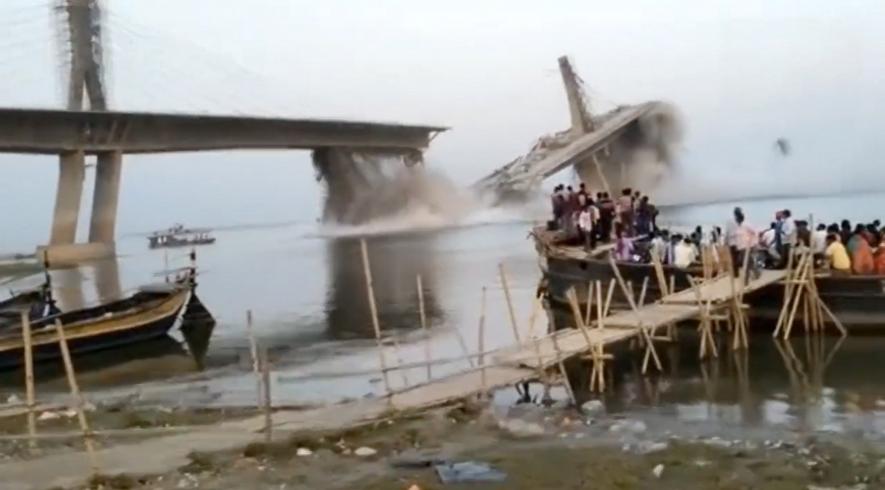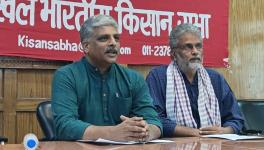Bihar’s Bridge Woes Shatter Dreams of its People

An under-construction Aguwani-Sultanganj Ganga bridge collapsed, in Bihar's Bhagalpur district, Sunday, June 4, 2023. Image Courtesy: PTI
In Bihar, bridges are more than mere concrete structures. They symbolise hope for a brighter, unencumbered future and serve as a vital link between aspirations and reality. The state, however, has a history of bridge collapses, the most recent being the under-construction bridge connecting Sultanganj in the Bhagalpur district and Aguwani Ghat in the Khagaria district, which disintegrated on 4 June. This is the second incident in two years involving this bridge, and it raises questions about responsibility and accountability. So far, the project has missed eight deadlines, and it was in the last stages before completion when it collapsed last Sunday.
Almost 74% of North Bihar’s geographical area is prone to floods, which presents a challenging environment for infrastructure development. The state has numerous bridges and dams, yet security provisions remain inadequate. Who will take responsibility for these collapses, and what actions will the government take to prevent future incidents?
Over seven bridges have collapsed in Bihar in the past year alone; some made headlines, while others in remote areas went unnoticed. The quality of construction materials and the oversight of contractors and engineers have come under scrutiny. Yet the impact extends beyond infrastructure. The collapse of a bridge shatters the dreams of locals like Ravinder, a young boy from the Babraha village in Aguwani, whom this author met in Khagaria on the day the bridge collapsed. He had hoped that the upcoming bridge would provide him and his sister with better access to education and employment opportunities. However, its subsidence dashed their dreams, leaving them in limbo.
Standing at the site of the collapsed bridge, I couldn’t help but notice the palpable sense of despair and frustration among locals. Amid the rubble and debris, I met a group of villagers gathered to see the wreckage. One of them, a middle-aged woman named Archana, shared her story. A mother of three, Archana runs a small grocery store in her village. The completion of the Sultanganj-Aguwani Ghat bridge would have significantly reduced her travel time to the nearest market, allowing her to expand her business and provide her family with a better life. Tears in her eyes, she recounted how eagerly she had awaited the completion of this project, only to have her hopes dashed.
“I remember when my sister Sobha went into labour prematurely,” Archana said, her voice heavy with emotion. “We travelled for hours on bumpy roads to reach the hospital, but were too late. If this bridge had been completed, we would have reached the hospital much faster, and her baby might have had a chance.”
As we spoke, Arjun, a young man, joined our conversation. He recently completed his studies and was looking forward to starting work in a nearby town. The bridge would have made his daily commute feasible, but now he is forced to reconsider his options.
“I finally found a good job that would support my family,” Arjun said in a voice heavy with disappointment. “But without the bridge, I’ll have to spend hours travelling every day or even relocate, which would be a huge burden on my family.”
Ravindra, Archana and Arjun are just three of the countless people left with dreams shattered by the breaking apart of a bridge. The more I spoke with locals, the clearer it got that the impact of this disaster extended far beyond the loss of infrastructure. The bridge had come to symbolise a brighter future for them, and its collapse has left them feeling abandoned and disillusioned.
I cannot help but wonder what it would take for the government to recognise the urgency of the situation and take decisive action to address the root causes of these failures. Until then, the dreams of thousands will remain unfulfilled, and their path to a brighter future will continue to crumble.
Another particularly troubling example of Bihar’s infrastructure woes is the Dumariya Ghat bridge, which has been under construction for 14 years and remains unfinished. The pillars of this bridge were washed away in 2008, also during construction. The construction agency left the state and has not returned in 14 years. Over the past two years, the National Highways Authority of India (NHAI) has issued the tender for this contract four times, but not a single contractor has shown interest in building this structure. On 19 August 2022, the NHAI issued a notice saying the under-construction Dumariya Ghat bridge would be ready within one year. However, locals report no progress has been made so far. As it is the only road connecting the NHAI’s East-West corridor and linking North Bihar to Delhi, it affects the entire region’s population.
As the condition of Bihar’s bridges continues to deteriorate, Chief Minister Nitish Kumar has ordered a probe into the Sultanganj-Aguwani Ghat bridge collapse. However, until tangible action is taken to address the root causes, the people of Bihar will be left waiting for their dreams to be realised.
Bihar’s bridge crisis highlights the need to review construction practices, materials, and oversight comprehensively. The government must take swift action to rectify these issues and ensure future infrastructure projects are built to withstand the challenges of Bihar’s unique landscape. Moreover, the government must prioritise transparency and accountability in responding to these incidents. By holding contractors, engineers, and officials responsible for their actions, the state can work towards restoring public trust in its projects.
It is essential to recognise the broader implications of this crisis. The state’s infrastructure woes hinder economic growth and development and exacerbate social inequalities. Access to quality education, healthcare, and employment opportunities is severely limited for those living in remote areas, further widening the gap between the haves and have-nots.
These challenges cannot be resolved merely by repairing or reconstructing bridges. Even the IIT Roorkee report on the Sultanganj-Aguwani bridge collapse has said it cannot be repaired or reconstructed, and the project must now start afresh with a new design. In 2017, the rail and road links between North Bihar and the Northeastern states were snapped during the floods, leaving people and supplies stranded for miles on end. The state government must invest in alternative transportation options, such as inland waterways and better road networks, to ensure people in flood-prone areas have reliable means of transportation during emergencies.
The government must also consider stricter regulations and quality control measures for its construction projects, especially regular inspections and audits. This would help identify potential issues before they escalate into full-blown disasters, safeguarding the lives and dreams of Bihar’s residents.
It is essential to involve local communities in the planning and decision-making processes for infrastructure projects. Incorporating local insights and concerns can help the government tailor projects to the unique needs of each region and distribute the benefits equitably.
In the face of adversity, the people of Bihar have shown remarkable resilience and determination. However, the government is responsible for providing them with the necessary resources to build a better future. By addressing the underlying causes of the bridge crisis and implementing comprehensive, long-term solutions, Bihar can pave the way for a brighter, more prosperous future for all its residents.
The author is a development economist. The views are personal.
Get the latest reports & analysis with people's perspective on Protests, movements & deep analytical videos, discussions of the current affairs in your Telegram app. Subscribe to NewsClick's Telegram channel & get Real-Time updates on stories, as they get published on our website.
























